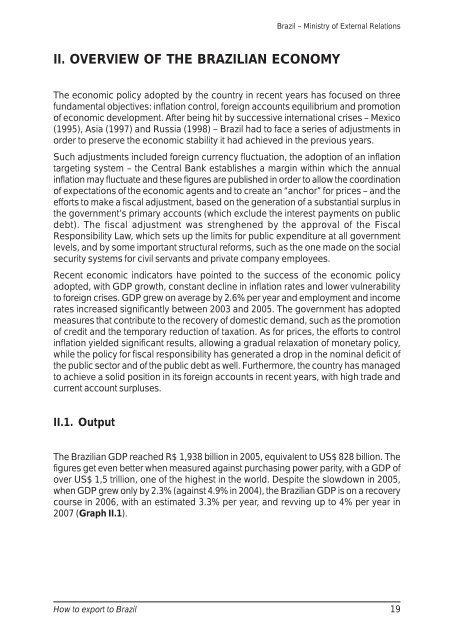How to Export to Brazil - Sprint Lazio
How to Export to Brazil - Sprint Lazio
How to Export to Brazil - Sprint Lazio
Create successful ePaper yourself
Turn your PDF publications into a flip-book with our unique Google optimized e-Paper software.
<strong>Brazil</strong> – Ministry of External Relations<br />
II. OVERVIEW OF THE BRAZILIAN ECONOMY<br />
The economic policy adopted by the country in recent years has focused on three<br />
fundamental objectives: inflation control, foreign accounts equilibrium and promotion<br />
of economic development. After being hit by successive international crises – Mexico<br />
(1995), Asia (1997) and Russia (1998) – <strong>Brazil</strong> had <strong>to</strong> face a series of adjustments in<br />
order <strong>to</strong> preserve the economic stability it had achieved in the previous years.<br />
Such adjustments included foreign currency fluctuation, the adoption of an inflation<br />
targeting system – the Central Bank establishes a margin within which the annual<br />
inflation may fluctuate and these figures are published in order <strong>to</strong> allow the coordination<br />
of expectations of the economic agents and <strong>to</strong> create an “anchor” for prices – and the<br />
efforts <strong>to</strong> make a fiscal adjustment, based on the generation of a substantial surplus in<br />
the government’s primary accounts (which exclude the interest payments on public<br />
debt). The fiscal adjustment was strenghened by the approval of the Fiscal<br />
Responsibility Law, which sets up the limits for public expenditure at all government<br />
levels, and by some important structural reforms, such as the one made on the social<br />
security systems for civil servants and private company employees.<br />
Recent economic indica<strong>to</strong>rs have pointed <strong>to</strong> the success of the economic policy<br />
adopted, with GDP growth, constant decline in inflation rates and lower vulnerability<br />
<strong>to</strong> foreign crises. GDP grew on average by 2.6% per year and employment and income<br />
rates increased significantly between 2003 and 2005. The government has adopted<br />
measures that contribute <strong>to</strong> the recovery of domestic demand, such as the promotion<br />
of credit and the temporary reduction of taxation. As for prices, the efforts <strong>to</strong> control<br />
inflation yielded significant results, allowing a gradual relaxation of monetary policy,<br />
while the policy for fiscal responsibility has generated a drop in the nominal deficit of<br />
the public sec<strong>to</strong>r and of the public debt as well. Furthermore, the country has managed<br />
<strong>to</strong> achieve a solid position in its foreign accounts in recent years, with high trade and<br />
current account surpluses.<br />
II.1. Output<br />
The <strong>Brazil</strong>ian GDP reached R$ 1,938 billion in 2005, equivalent <strong>to</strong> US$ 828 billion. The<br />
figures get even better when measured against purchasing power parity, with a GDP of<br />
over US$ 1,5 trillion, one of the highest in the world. Despite the slowdown in 2005,<br />
when GDP grew only by 2.3% (against 4.9% in 2004), the <strong>Brazil</strong>ian GDP is on a recovery<br />
course in 2006, with an estimated 3.3% per year, and revving up <strong>to</strong> 4% per year in<br />
2007 (Graph II.1).<br />
<strong>How</strong> <strong>to</strong> export <strong>to</strong> <strong>Brazil</strong> 19


